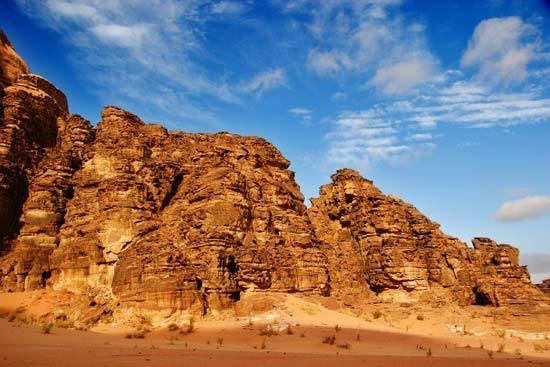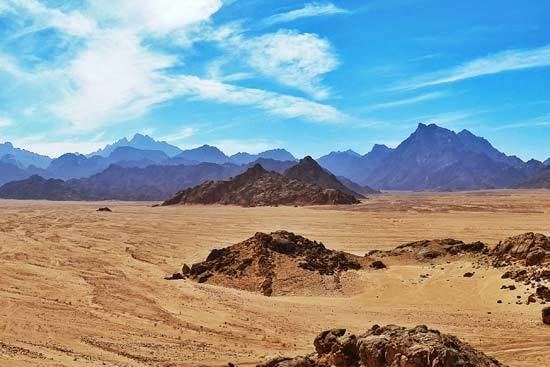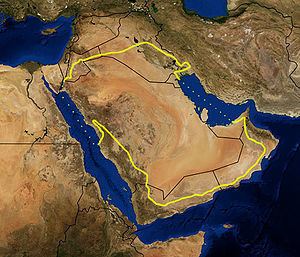Area 2.33 million km² | Biome Desert | |
 | ||
Discover a hidden oasis in the arabian desert a broad abroad on yahoo travel
The Arabian Desert is located in Western Asia. It is a vast desert wilderness stretching from Yemen to the Persian Gulf and Oman to Jordan and Iraq. It occupies most of the Arabian Peninsula, with an area of 2,330,000 square kilometers (900,000 sq mi). At its center is the Rub'al-Khali, one of the largest continuous bodies of sand in the world. Gazelles, oryx, sand cats, and spiny-tailed lizards are just some of the desert-adapted species that survive in this extreme environment, which features everything from red dunes to deadly quicksand. The climate is mostly dry (the major part receives around 100 mm of rain per year but some very rare places receives down to 50 mm), and temperatures oscillate between very high heat and seasonal night time freezes. It is part of the Deserts and xeric shrublands biome and the Palearctic ecozone. This ecoregion holds little biodiversity, although a few endemic plants grow here. Many species, such as the striped hyena, jackal and honey badger have become extinct in this area due to hunting, human encroachment and habitat destruction. Other species have been successfully re-introduced, such as the sand gazelle, and are protected at a number of reserves. Overgrazing by livestock, off-road driving, and human destruction of habitat are the main threats to this desert ecoregion.
Contents
- Discover a hidden oasis in the arabian desert a broad abroad on yahoo travel
- Trapped in a sand bowl ben and james versus the arabian desert preview bbc two
- Geology and geography
- Climate
- Political borders
- People language and cultures
- Ecological threats
- Military activity
- Conservation
- Oil Spills
- References

Trapped in a sand bowl ben and james versus the arabian desert preview bbc two
Geology and geography
Detailed geological features:

Climate
The Arabian Desert has a subtropical, hot desert climate, close to the climate of the Sahara Desert, the world's largest hot desert located in North Africa. In fact, the Arabian Desert is an extension of the Sahara Desert over the Arabian peninsula. The climate is mainly hot and dry with plenty of sunshine throughout the year.

The rainfall amount is generally around 100 mm, and the driest areas can receive between 30 and 40 mm of annual rain. Such dryness remains very rare throughout the desert, however. There are hardly any hyperarid areas in the Arabian Desert, in contrast with the Sahara Desert, where more than half of the area is hyperarid (annual rainfall below 50 mm).
The sunshine duration is very high by global standards in the Arabian Desert, between 2,900 hours (66.2% of the daylight hours) and 3,600 hours (82.1% of the daylight hours) but is typically around 3,400 hours (77.6% of the daylight hours), which clearly indicates clear-sky conditions prevails over the region and cloudy periods are just intermittent. Even though the sun and moon is bright, the dust and humidity has a lower visibility for the traveler.
The temperatures remain high all year round. Average high temperatures in summer are generally over 40 °C (104 °F) at low elevations, and can even soar to 48 °C (114.8 °F) at extremely low elevations, especially along the Persian Gulf near the sea level. Average low temperatures in summer remain high, over 20 °C (68 °F) and sometimes over 30 °C (77 °F) in the southernmost regions. Record high temperatures are above 50 °C (122 °F) in much of the desert, due in part to very low elevation.
Political borders
The desert lies mostly in Saudi Arabia, extending into the surrounding countries of Egypt (Sinai), southern Iraq and southern Jordan. The Arabian desert is bordered by 5 countries. Bordering the Persian Gulf, there is an extension into Qatar and, further east, the region covers almost all of Abu Dhabi in the United Arab Emirates (UAE). The Rub'al-Khali crosses over from Saudi Arabia into western Oman and eastern Yemen.
People, language and cultures
The area is home to several different cultures, languages, and peoples, with Islam as the predominant faith. The major ethnic group in the region is the Arabs, whose primary language is Arabic.
Ecological threats
Military activity
Weaponry used by the United States during the Gulf War also poses a huge risk to the environmental stability of the area. Tank columns in the desert plains may disrupt the fragile stability that exists in the desert currently. In 1991, the movement of US tanks over the desert damaged the top protective layer of the desert soil. As a result, a sand dune was released and has started slowly moving downhill. Some people fear this dune could ultimately reach Kuwait City.
Conservation
The conservation status of the desert is critical/endangered, with species including the sand gazelle and white oryx threatened, and honey badgers, jackals, and striped hyaenas already extirpated.
No formal protected areas exist, but a number of protected areas are planned for Abu Dhabi.
Oil Spills
In January 1991 during the Gulf War, Iraqi forces released about 1.7 million m³ (11 million barrels) of oil from storage tanks and tankers directly into the Persian Gulf. In February, they also destroyed 1,164 Kuwaiti oil wells. It took nine months to extinguish these oil fires. These oil spills contaminated 1,000 km (620 mi) of Persian Gulf coast.
The result of the pollution was the death of thousands of water birds and serious damage to the Persian Gulf's aquatic ecosystem, particularly shrimp, sea turtles, dugongs, whales, dolphins and fish.
The damaged wells also released 10 million m³ (60 million barrels) of oil into the desert and formed lakes (total surface of 49 square kilometers).
